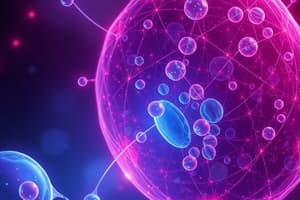Podcast
Questions and Answers
Which phase of the cell cycle is a period of DNA synthesis in which nuclear DNA is replicated?
Which phase of the cell cycle is a period of DNA synthesis in which nuclear DNA is replicated?
- S phase (correct)
- G1 phase
- G2 phase
- M phase
What characterizes the G0 phase of the cell cycle?
What characterizes the G0 phase of the cell cycle?
- Cell growth
- Intensive metabolic activity
- Visible chromosomes
- Nonproliferative state (correct)
Which phase of the cell cycle follows mitosis and is a period of growth and metabolic activity?
Which phase of the cell cycle follows mitosis and is a period of growth and metabolic activity?
- G2 phase
- G1 phase (correct)
- S phase
- M phase
What is the initial phase of the cell cycle called?
What is the initial phase of the cell cycle called?
What is the actual process of mitosis's duration in the cell cycle?
What is the actual process of mitosis's duration in the cell cycle?
What occurs during the G2 phase of the cell cycle?
What occurs during the G2 phase of the cell cycle?
What is the characteristic of cells in the G0 phase of the cell cycle?
What is the characteristic of cells in the G0 phase of the cell cycle?
Which pathway transduces the mitogenic signal through G-proteins and phospholipase C?
Which pathway transduces the mitogenic signal through G-proteins and phospholipase C?
Which antibiotic inhibits the synthesis of cell wall in bacterial cells?
Which antibiotic inhibits the synthesis of cell wall in bacterial cells?
Which of the following drugs stabilizes microtubules and interferes with their normal breakdown during cell division?
Which of the following drugs stabilizes microtubules and interferes with their normal breakdown during cell division?
Which platinum-containing anti-cancer drug binds to and causes cross-linking of DNA?
Which platinum-containing anti-cancer drug binds to and causes cross-linking of DNA?
Which enzyme is inhibited by gemcitabine, leading to apoptosis?
Which enzyme is inhibited by gemcitabine, leading to apoptosis?
Which of the following is an inhibitor of epidermal growth factor receptor?
Which of the following is an inhibitor of epidermal growth factor receptor?
Which exogenous growth factor is often used to stimulate cell division in 'in vitro' conditions?
Which exogenous growth factor is often used to stimulate cell division in 'in vitro' conditions?
Which endogenous growth factor stimulates the growth of nerve cells and nerve protuberances?
Which endogenous growth factor stimulates the growth of nerve cells and nerve protuberances?
Which toxin inhibits the microtubule polymerization by acting as a toxic alkaloid?
Which toxin inhibits the microtubule polymerization by acting as a toxic alkaloid?
What is the role of dyneins in cell division?
What is the role of dyneins in cell division?
What characterizes anaphase B in cell division?
What characterizes anaphase B in cell division?
What occurs during the process of karyokinesis?
What occurs during the process of karyokinesis?
What is the final stage of mitosis characterized by?
What is the final stage of mitosis characterized by?
What is the function of the contractile ring of actin filaments with myosin II during cytokinesis?
What is the function of the contractile ring of actin filaments with myosin II during cytokinesis?
What regulates cell division and cell cycle at the cellular level?
What regulates cell division and cell cycle at the cellular level?
What is the function of mitogens in regulating mitotic events?
What is the function of mitogens in regulating mitotic events?
During which phase do sister chromatids of each chromosome separate and migrate to opposite ends of the cell?
During which phase do sister chromatids of each chromosome separate and migrate to opposite ends of the cell?
What is the period of chromosome movement referred to as?
What is the period of chromosome movement referred to as?
What ensures that both daughter cells arising by mitosis will have the same genetic information?
What ensures that both daughter cells arising by mitosis will have the same genetic information?
What forms the aster, radiating outward from the centrosome toward the cortex of the cell?
What forms the aster, radiating outward from the centrosome toward the cortex of the cell?
What is the chromosome configuration following the period of chromosome movement in mitotic division?
What is the chromosome configuration following the period of chromosome movement in mitotic division?
What marks the completion of Metaphase in mitotic division?
What marks the completion of Metaphase in mitotic division?
What is formed on opposite sides of the centromere during Prophase in mitotic division?
What is formed on opposite sides of the centromere during Prophase in mitotic division?
Study Notes
Overview of Mitotic Division and Chromosome Structure
- Eukaryotic chromosomes consist of DNA and proteins called histones and non-histones, forming a higher structure called chromatin.
- Mitotic division is typical for eukaryotic somatic cells and can be divided into discrete phases: Prophase, Prometaphase, Metaphase, Anaphase, and Telophase.
- During Prophase, centrosomes with centriole pairs migrate to opposite poles of the cell, and the nucleolus disappears as chromatin condenses into chromatids.
- Kinetochore structures are formed on opposite sides of the centromere, with external areas attaching to spindle fibers.
- Prometaphase refers to the period of chromosome movement, while Metaphase is the chromosome configuration following this movement, with microtubules forming kinetochore, polar, and astral microtubules.
- At the completion of Metaphase, chromosomes are arranged randomly, with each centromere aligned at the metaphase plane.
- In Anaphase, sister chromatids of each chromosome separate and migrate to opposite ends of the cell, marked by the division of each centromere region into two and separation of daughter chromatids.
- Anaphase is divided into two stages: Anaphase A, characterized by the shortening of kinetochore microtubules, and Anaphase B, where kinesins slide polar microtubules to generate force for centrosome separation.
- DNA replication during the S phase ensures that both daughter cells arising by mitosis will have the same genetic information.
- Chromatin condensation and higher-level DNA supercoiling of the 30-nm fiber produce the metaphase chromosome during mitosis.
- The spindle fibers consist of microtubules formed by tubulin, with kinetochore microtubules anchoring to kinetochores and polar microtubules providing the cytoplasmic framework for spindle fibers.
- Astral microtubules form the aster, radiating outward from the centrosome toward the cortex of the cell, helping to position the mitotic apparatus and determine the cleavage plane during cytokinesis.
Studying That Suits You
Use AI to generate personalized quizzes and flashcards to suit your learning preferences.
Description
Test your knowledge of mitotic division and chromosome structure with this quiz. Explore the phases of mitosis, chromosome configurations, and the role of spindle fibers and microtubules in cell division.




